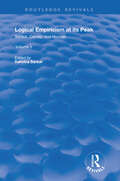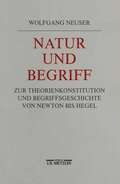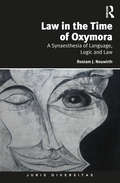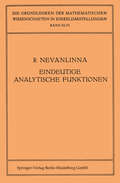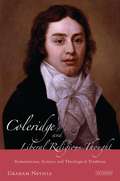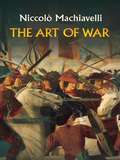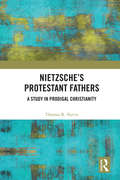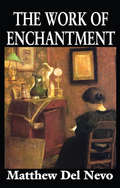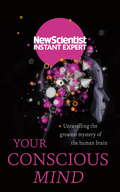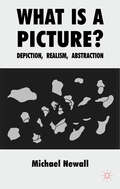- Table View
- List View
Einführung in die Philosophie der Mathematik
by Jörg NeunhäusererWelche Art von Gegenständen untersucht die Mathematik und in welchem Sinne existieren diese Gegenstände? Warum dürfen wir die Aussagen der Mathematik zu unserem Wissen zählen und wie lassen sich diese Aussagen rechtfertigen? Eine Philosophie der Mathematik versucht solche Fragen zu beantworten. In dieser Einführung stellen wir maßgebliche Positionen in der Philosophie der Mathematik vor und formulieren die Essenz dieser Positionen in möglichst einfachen Thesen. Der Leser erfährt, auf welche Philosophen eine Position zurückgeht und in welchem historischen Kontext diese entstand. Ausgehend von Grundintuitionen und wissenschaftlichen Befunden lässt sich für oder gegen eine These in der Philosophie der Mathematik argumentieren. Solche Argumente bilden den zweiten Schwerpunkt dieses Buchs. Das Buch soll den Leser dazu anregen, über die Philosophie der Mathematik nachzudenken und eine eigene Position zu formulieren und für diese zu argumentieren.
Philosophical Papers 1913–1946: With a Bibliography of Neurath in English (Vienna Circle Collection #16)
by M. NeurathThe philosophical writings of Otto Neurath, and their central themes, have been described many times, by Carnap in his authobiographical essay, by Ayer and Morris and Kraft decades ago, by Haller and Hegselmann and Nemeth and others in recent years. How extraordinary Neurath's insights were, even when they perhaps were more to be seen as conjectures, aperfus, philosophical hypotheses, tools to be taken up and used in the practical workshop of life; and how prescient he was. A few examples may be helpful: (1) Neurath's 1912 lecture on the conceptual critique of the idea of a pleasure maximum [ON 50] substantially anticipates the development of aspects of analytical ethics in mid-century. (2) Neurath's 1915 paper on alternative hypotheses, and systems of hypotheses, within the science of physical optics [ON 81] gives a lucid account of the historically-developed clashing theories of light, their un realized further possibilities, and the implied contingencies of theory survival in science, all within his framework that antedates not only the quite similar work of Kuhn so many years later but also of the Vienna Circle too. (3) Neurath's subsequent paper of 1916 investigates the inadequacies of various attempts to classify systems of hypotheses [ON 82, and this volume], and sets forth a pioneering conception of the metatheoretical task of scientific philosophy.
Empiricism and Sociology (Vienna Circle Collection #1)
by M. Neurath Robert S. CohenOn the last day of his life, Otto Neurath had given help to a Chinese philosopher who was writing about Schlick. Only an hour before his death he said to me: "Nobody will do such a thing for me." My answer then was: "Never mind, you have Bilston, isn't that better?" There were con sultations in new housing schemes, an exhibition, and hopes for a fruitful relationship of longer duration. I did not dream at that time that I would one day work on a book like this. The idea came from Horace M. Kallen, of the New School for Social Research, New York, years later; to encourage me he sent me his selection from William James' writings. Later I met Robert S. Cohen. Carnap had sent him to me with the message: "If you want to find out what my political views were in the twenties and thirties, read Otto Neurath's books and articles of that time; his views were also mine." In this way Robert Cohen became ac quainted with Otto Neurath. Even more: he became interested; and when I asked him, would he help me as an editor of an Otto N eurath volume, he agreed at once. In previous years I had already asked a number of Otto Neurath's friends to write down for me what they especially remembered about him.
Logical Empiricism at Its Peak: Schlick, Carnap, and Neurath
by Maria Neurath Sahotra Sarkar Moritz Schlick Rudolf CarnapFirst Published in 1996. This volume reprints pieces from the Vienna Circle period between the manifesto and the adoption of semantics, as well as two commentaries. During this period, the logical empiricists were the most ambitious and the most confident about the success of their enterprise. The first section consists of four ideological classics, The second section reprints three papers on physicalism. The third section consists of three papers on logic and the fourth on reprints three papers on truth, induction, and confirmation.
Logical Empiricism at Its Peak: Schlick, Carnap, and Neurath
by Maria Neurath Sahotra Sarkar Moritz Schlick Rudolf CarnapFirst Published in 1996. This volume reprints pieces from the Vienna Circle period between the manifesto and the adoption of semantics, as well as two commentaries. During this period, the logical empiricists were the most ambitious and the most confident about the success of their enterprise. The first section consists of four ideological classics, The second section reprints three papers on physicalism. The third section consists of three papers on logic and the fourth on reprints three papers on truth, induction, and confirmation.
Economic Writings: Selections 1904-1945 (Vienna Circle Collection #23)
by Otto NeurathThis book makes available for the first time in English a substantial part of Otto Neurath's economic writings. The essays and small monographs translated here extend from his student years to his last ever finished piece. They chart not only Neurath's varied interests in the economic history of antiquity, in war economics and schemes for the socialisation of peacetime economies, in the theory of welfare measures and social indicators and in issues of the theory of collective choice, but also show his philosophical interests emerging in his contributions to seminal debates of the German Social Policy Association. This volume shows that Neurath's important contributions to the socialist calculation debate are but one aspect of a many-sided and original oeuvre. The translations are preceded by an introductory essay by one of the editors which contextualises the selections by locating them in the various debates of the time that provided their original setting. This book is of interest to economists, philosophers of social science and of economics as well as to historians of philosophy of science and of analytic philosophy.
Natur und Begriff: Zur Theoriekonstitution und Begriffsgeschichte von Newton bis Hegel
by Wolfgang NeuserModerne Naturwissenschaft lässt sich methodisch und inhaltlich nicht ohne ihre vielfältigen Bezüge zur Philosophie verstehen. Vor dem Hintergrund einer Theorie einer Begriffsgeschichte naturwissenschaftlicher Begriffe stellt Wolfgang Neuser in diesem Buch historische Fallbeispiele vom 17. bis zum 19. Jahrhundert gleichsam als empirisches Material einer philosophischen Untersuchung vor.
Natur und Begriff: Studien zur Theoriekonstitution und Begriffsgeschichte von Newton bis Hegel
by Wolfgang NeuserVor dem Hintergrund einer Theorie einer Begriffsgeschichte naturwissenschaftlicher Begriffe stellt Wolfgang Neuser in diesem Buch historische Fallbeispiele vom 17. bis zum 19. Jahrhundert gleichsam als empirisches Material einer philosophischen Untersuchung vor.
Wissen begreifen: Zur Selbstorganisation von Erfahrung, Handlung und Begriff
by Wolfgang NeuserDas Internet, elektronische Medien und intelligente Wissenssysteme haben unseren Umgang mit Wissen grundlegend verändert – und mit ihm unsere traditionellen Begriffe von Wissen und Rationalität. Wolfgang Neuser, Philosophieprofessor an der TU Kaiserslautern, stellt in seiner begriffstheoretischen Untersuchung einen Wissensbegriff vor, der einen neuen Schlüssel zum Verständnis ideengeschichtlicher Epochen, kultureller Traditionen und Konflikte in traditionellen und nichttraditionellen Entwicklungsphasen einer Gesellschaft liefert: Wissen ist ein sich selbst organisierendes und stabilisierendes System, in dem der Mensch seine Mittelpunktstellung als denkendes Subjekt verloren hat: Was von den menschlichen Akteuren bleibt, ist das Individuum, das sein individuelles Wissen aus der Interaktion mit Allgemeinwissen bezieht.
Law in the Time of Oxymora: A Synaesthesia of Language, Logic and Law (Juris Diversitas)
by Rostam J. NeuwirthWhat do different concepts like true lie, bad luck, honest thief, old news, spacetime, glocalization, symplexity, sustainable development, constant change, soft law, substantive due process, pure law, bureaucratic efficiency and global justice have in common? What connections do they share with innumerable paradoxes, like the ones of happiness, time, globalization, sex, and of free will and fate? Law in the Time of Oxymora provides answers to these conundrums by critically comparing the apparent rise in recent years of the use of rhetorical figures called "essentially oxymoronic concepts" (i.e. oxymoron, enantiosis and paradoxes) in the areas of art, science and law. Albeit to varying degrees, these concepts share the quality of giving expression to apparent contradictions. Through this quality, they also challenge the scientific paradigm rooted in the dualistic thinking and binary logic that is traditionally used in the West, as opposed to the East, where a paradoxical mode of thinking and fuzzy logic is said to have been cultivated. Following a review of oxymora and paradoxes in art and various scientific writings, hundreds of "hard cases" featuring oxymora and a comprehensive review of the legal literature are discussed, revealing evidence suggesting that the present scientific paradigm of dualism alone will no longer be able to tackle the challenges arising from increasing diversity and complexity coupled with an apparent acceleration of change. Law in the Time of Oxymora reaches the surprising conclusion that essentially oxymoronic concepts may inaugurate a new era of cognition, involving the ways the senses interact and how we reason, think and make decisions in law and in life.
Law in the Time of Oxymora: A Synaesthesia of Language, Logic and Law (Juris Diversitas)
by Rostam J. NeuwirthWhat do different concepts like true lie, bad luck, honest thief, old news, spacetime, glocalization, symplexity, sustainable development, constant change, soft law, substantive due process, pure law, bureaucratic efficiency and global justice have in common? What connections do they share with innumerable paradoxes, like the ones of happiness, time, globalization, sex, and of free will and fate? Law in the Time of Oxymora provides answers to these conundrums by critically comparing the apparent rise in recent years of the use of rhetorical figures called "essentially oxymoronic concepts" (i.e. oxymoron, enantiosis and paradoxes) in the areas of art, science and law. Albeit to varying degrees, these concepts share the quality of giving expression to apparent contradictions. Through this quality, they also challenge the scientific paradigm rooted in the dualistic thinking and binary logic that is traditionally used in the West, as opposed to the East, where a paradoxical mode of thinking and fuzzy logic is said to have been cultivated. Following a review of oxymora and paradoxes in art and various scientific writings, hundreds of "hard cases" featuring oxymora and a comprehensive review of the legal literature are discussed, revealing evidence suggesting that the present scientific paradigm of dualism alone will no longer be able to tackle the challenges arising from increasing diversity and complexity coupled with an apparent acceleration of change. Law in the Time of Oxymora reaches the surprising conclusion that essentially oxymoronic concepts may inaugurate a new era of cognition, involving the ways the senses interact and how we reason, think and make decisions in law and in life.
Eindeutige Analytische Funktionen (Grundlehren der mathematischen Wissenschaften #46 )
by Rolf Herman NevanlinnaDieser Buchtitel ist Teil des Digitalisierungsprojekts Springer Book Archives mit Publikationen, die seit den Anfängen des Verlags von 1842 erschienen sind. Der Verlag stellt mit diesem Archiv Quellen für die historische wie auch die disziplingeschichtliche Forschung zur Verfügung, die jeweils im historischen Kontext betrachtet werden müssen. Dieser Titel erschien in der Zeit vor 1945 und wird daher in seiner zeittypischen politisch-ideologischen Ausrichtung vom Verlag nicht beworben.
Coleridge and Liberal Religious Thought: Romanticism, Science and Theological Tradition (International Library of Historical Studies)
by Graham NevilleFew figures who were active in the English Romantic Movement are as fascinating as Samuel Taylor Coleridge (1772-1834). Aside from his own visionary verse, Coleridge is famous for his colourful friendships with fellow-poets Wordsworth and Southey, and above all for his well documented drug-taking and creative use of opium. But it is altogether less widely appreciated that he was also a key figure in Anglican thought, whose writings are continually referred to by modern Anglican theologians. Coleridge's journey from the Unitarianism of his father towards a later commitment to Anglican Trinitarianism of a type he had rejected in his youth involved a rigorous philosophical process of imaginative liberal thinking. Over the last 200 years, that thinking has provided Anglicanism with many valedictory tools as well as a measure of robust self-belief. Offering a major contribution both to religious history and the history of ideas, Graham Neville here charts the particular liberal tradition in British religious thought which stems directly from Coleridge. Beginning with an account of Coleridge's own spiritual pilgrimage, and the roots of his subject's theology in 17th century writers like John Donne and the Cambridge Platonists, Dr Neville explores Coleridge's quest for a version of Christian orthodoxy which satisfied his Romantic convictions about revelation and his personal need for redemption. Neville explains why Coleridge's thought remains so significant, and traces the ways in which the latter's theological ideas profoundly influenced later British writers and scholars like F. D. Maurice, F. J. A. Hort, F. W. Robertson, B. F. Westcott, John Oman and Thomas Erskine (once called the 'Scottish Coleridge'). The author shows that Coleridge's thinking was influential as far away as New England, especially amongst those who sought to move beyond Calvinist rigidities. Dr Neville further relates the humane ideas of Coleridge to topical modern developments in theology, and shows how Coleridge has inspired subsequent thinkers to pioneer new scientific methods and democratic ideals.
The Art of War
by Henry Neville Niccolò MachiavelliFlorentine statesman, writer, and political theorist, Niccolò Machiavelli (1469-1527) considered The Art of War his most important work. Five centuries later, after serving as a guide to Frederick the Great, Napoleon, and countless other military leaders, it remains an authoritative treatise on the fundamentals of warfare.Best known as the political theorist who wrote The Prince, Machiavelli used this book to advocate strategies for Italy's increased military prowess and political strength. Machiavelli was the first to propose a global context for the functional unity of war and politics, with the former serving as an instrument of the latter. Written in the form of dialogues, this 1520 work represents a humanistic treatment rather than a textbook approach. It clearly states and discusses the fundamentals of military organization and strategy: handling recruitment and weapons, motivating troops, demoralizing enemies, and achieving tactical and strategic advantages. Essential to the education of students of military history, strategy, and theory, The Art of War continues to inspire readers.
Nietzsche's Protestant Fathers: A Study in Prodigal Christianity
by Thomas R. NevinNietzsche was famously an atheist, despite coming from a strongly Protestant family. This heritage influenced much of his thought, but was it in fact the very thing that led him to his atheism? This work provides a radical re-assessment of Protestantism by documenting and extrapolating Nietzsche’s view that Christianity dies from the head down. That is, through Protestantism’s inherent anarchy. In this book, Nietzsche is put into conversation with the initiatives of several powerful thinking writers; Luther, Boehme, Leibniz, and Lessing. Using Nietzsche as a critical guide to the evolution of Protestant thinking, each is shown to violate, warp, or ignore gospel injunctions, and otherwise pose hazards to the primacy of Christian ethics. Demonstrating that a responsible understanding of Protestantism as a historical movement needs to engage with its inherent flaws, this is a text that will engage scholars of philosophy, theology, and religious studies alike.
Nietzsche's Protestant Fathers: A Study in Prodigal Christianity
by Thomas R. NevinNietzsche was famously an atheist, despite coming from a strongly Protestant family. This heritage influenced much of his thought, but was it in fact the very thing that led him to his atheism? This work provides a radical re-assessment of Protestantism by documenting and extrapolating Nietzsche’s view that Christianity dies from the head down. That is, through Protestantism’s inherent anarchy. In this book, Nietzsche is put into conversation with the initiatives of several powerful thinking writers; Luther, Boehme, Leibniz, and Lessing. Using Nietzsche as a critical guide to the evolution of Protestant thinking, each is shown to violate, warp, or ignore gospel injunctions, and otherwise pose hazards to the primacy of Christian ethics. Demonstrating that a responsible understanding of Protestantism as a historical movement needs to engage with its inherent flaws, this is a text that will engage scholars of philosophy, theology, and religious studies alike.
The Work of Enchantment
by Matthew Del NevoThe Work of Enchantment suggests that it is a lack of "enchantment" in rich, developed countries that causes soul-starved Westerners to experience mental (and sometimes physical) illness. Del Nevo argues that this "enchantment" is most often experienced in childhood, but can also be found in adulthood, particularly through art. However, adults must cultivate within themselves the ability to appreciate art by reading, listening, and gazing-activities often misconceived in advanced industrial societies. Del Nevo describes the framework of enchantment and its philosophical and historical roots. He then concentrates on the work of enchantment within literature, considering what enchantment might entail taking the works of Proust, Rilke, and Goethe as examples. Del Nevo shows how a sense of enchantment forms within and between art works, using his literary examples, as well as between the work and the audience. The reader will learn along the way that enchantment may be found in the power of words, as an expression of the desire of the soul, a compliment of melancholy, and in art that points to something beyond itself. Enchantment may be found in many places, ranging from philosophy, religion, and psychology to sociology and culture, but here Del Nevo focuses on literature. His audience is people who are searching for something beyond money or glamour-perhaps the meaning of art and culture. His focus on literary masterpieces such as the Duino Elegies, Remembrance of Things Past, Wilhelm Meister's Journeyman Years, and others will make it of interest to those in cultural studies. Well written and engaging, and accessible to non-specialist readers, this unusual work in philosophy and aesthetics is free of jargon and complicated verbiage. Inspiring and enlivening, it is, in the author's words, "a stirring call to idleness."
The Work of Enchantment
by Matthew Del NevoThe Work of Enchantment suggests that it is a lack of "enchantment" in rich, developed countries that causes soul-starved Westerners to experience mental (and sometimes physical) illness. Del Nevo argues that this "enchantment" is most often experienced in childhood, but can also be found in adulthood, particularly through art. However, adults must cultivate within themselves the ability to appreciate art by reading, listening, and gazing-activities often misconceived in advanced industrial societies. Del Nevo describes the framework of enchantment and its philosophical and historical roots. He then concentrates on the work of enchantment within literature, considering what enchantment might entail taking the works of Proust, Rilke, and Goethe as examples. Del Nevo shows how a sense of enchantment forms within and between art works, using his literary examples, as well as between the work and the audience. The reader will learn along the way that enchantment may be found in the power of words, as an expression of the desire of the soul, a compliment of melancholy, and in art that points to something beyond itself. Enchantment may be found in many places, ranging from philosophy, religion, and psychology to sociology and culture, but here Del Nevo focuses on literature. His audience is people who are searching for something beyond money or glamour-perhaps the meaning of art and culture. His focus on literary masterpieces such as the Duino Elegies, Remembrance of Things Past, Wilhelm Meister's Journeyman Years, and others will make it of interest to those in cultural studies. Well written and engaging, and accessible to non-specialist readers, this unusual work in philosophy and aesthetics is free of jargon and complicated verbiage. Inspiring and enlivening, it is, in the author's words, "a stirring call to idleness."
Philosophy of Literature: An Introduction
by Christopher NewLiterature, like the visual arts, poses its own philosophical problems. While literary theorists have discussed the nature of literature intensively, analytic philosophers have usually dealt with literary problems either within the general framework of aesthetics or else in a way that is accessible only to a philosophical audience. The present book is unique in that it introduces the philosophy of literature from an analytic perspective accessible to both students of literature and students of philosophy. Specifically, the book addresses: the definition of literature, the distinction between oral and written literature and the identity of literary worksthe nature of fiction and our emotional involvement with fictional charactersthe concept of imagination and its role in the apprehension of literary workstheories of metaphor and postmodernist theory on the significance of the authors' intentions to the interpretationof their workan examination of the relevance of thruth and morality to literary appreciationLucid and well organised and free from jargon, hilosophy of Literature: An Introduction offers fresh approaches to traditional problems and raises new issues in the philosophy of literature.
Philosophy of Literature: An Introduction
by Christopher NewLiterature, like the visual arts, poses its own philosophical problems. While literary theorists have discussed the nature of literature intensively, analytic philosophers have usually dealt with literary problems either within the general framework of aesthetics or else in a way that is accessible only to a philosophical audience. The present book is unique in that it introduces the philosophy of literature from an analytic perspective accessible to both students of literature and students of philosophy. Specifically, the book addresses: the definition of literature, the distinction between oral and written literature and the identity of literary worksthe nature of fiction and our emotional involvement with fictional charactersthe concept of imagination and its role in the apprehension of literary workstheories of metaphor and postmodernist theory on the significance of the authors' intentions to the interpretationof their workan examination of the relevance of thruth and morality to literary appreciationLucid and well organised and free from jargon, hilosophy of Literature: An Introduction offers fresh approaches to traditional problems and raises new issues in the philosophy of literature.
Your Conscious Mind: Unravelling the greatest mystery of the human brain (New Scientist Instant Expert)
by New ScientistWhat is this strange mental world that seems so essential to being human? The conscious mind brings together sensations, perceptions, thoughts and memories to generate the seamless movie of a person's life. It makes us aware of the world around us and our own self. How all this emerges from a kilogram of brain cells is one of the greatest unanswered questions. In Your Conscious Mind leading brain scientists and New Scientist take you on a journey through the mind to discover what consciousness really is, and what we can learn when it goes awry. Find out if we will ever build conscious machines, what animal consciousness can tell us about being human and explore the enigma of free will. ABOUT THE SERIESNew Scientist Instant Expert books are definitive and accessible entry points to the most important subjects in science; subjects that challenge, attract debate, invite controversy and engage the most enquiring minds. Designed for curious readers who want to know how things work and why, the Instant Expert series explores the topics that really matter and their impact on individuals, society, and the planet, translating the scientific complexities around us into language that's open to everyone, and putting new ideas and discoveries into perspective and context.
What is a Picture?: Depiction, Realism, Abstraction
by M. NewallUsing an approach deeply informed by philosophy of art, art history and perceptual psychology, this book places seeing at the centre of an original theory of pictorial representation and explores the ramifications such a theory has for the visual arts.
A Philosophy of the Art School (Routledge Research in Aesthetics)
by Michael Newall*Winner of the American Society for Aesthetics 2019 Outstanding Monograph Prize* Until now, research on art schools has been largely occupied with the facts of particular schools and teachers. This book presents a philosophical account of the underlying practices and ideas that have come to shape contemporary art school teaching in the UK, US and Europe. It analyses two models that, hidden beneath the diversity of contemporary artist training, have come to dominate art schools. The first of these is essentially an old approach: a training guided by the artistic values of a single artist-teacher. The second dates from the 1960s, and is based around the group crit, in which diverse voices contribute to an artist’s development. Understanding the underlying principles and possibilities of these two models, which sit together in an uneasy tension, gives new insights into the character of contemporary art school teaching, demonstrating how art schools shape art and artists, how they can be a potent engine of creativity in contemporary culture and how they contribute to artistic research. A Philosophy of the Art School draws on first-hand accounts of art school teaching, and is deeply informed by disciplines ranging from art history and art theory, to the philosophy of art, education and creativity.
A Philosophy of the Art School (Routledge Research in Aesthetics)
by Michael Newall*Winner of the American Society for Aesthetics 2019 Outstanding Monograph Prize* Until now, research on art schools has been largely occupied with the facts of particular schools and teachers. This book presents a philosophical account of the underlying practices and ideas that have come to shape contemporary art school teaching in the UK, US and Europe. It analyses two models that, hidden beneath the diversity of contemporary artist training, have come to dominate art schools. The first of these is essentially an old approach: a training guided by the artistic values of a single artist-teacher. The second dates from the 1960s, and is based around the group crit, in which diverse voices contribute to an artist’s development. Understanding the underlying principles and possibilities of these two models, which sit together in an uneasy tension, gives new insights into the character of contemporary art school teaching, demonstrating how art schools shape art and artists, how they can be a potent engine of creativity in contemporary culture and how they contribute to artistic research. A Philosophy of the Art School draws on first-hand accounts of art school teaching, and is deeply informed by disciplines ranging from art history and art theory, to the philosophy of art, education and creativity.
Plato at the Googleplex: Why Philosophy Won't Go Away
by Rebecca Newberger Newberger GoldsteinWhat would the ancient Greek philosopher make of the twenty-first-century Google headquarters?A dazzling exploration of the role of ancient philosophy in modern life from the acclaimed writer and thinker.Imagine that Plato came to life in the twenty-first century and embarked on a multi-city speaking tour. How would he mediate a debate between a Freudian psychoanalyst and a 'tiger mum' on how to raise the perfect child? How would he handle the host of a right-wing news program who denies there can be morality without religion? What would Plato make of Google, and of the idea that knowledge can be crowdsourced rather than reasoned out by experts? Plato at the Googleplex is acclaimed thinker Rebecca Newberger Goldstein's dazzling investigation of these conundra. With a philosopher's depth and erudition and a novelist's imagination and wit, Goldstein probes the deepest issues confronting us by allowing us to eavesdrop on Plato as he takes on the modern world; it is a stunningly original plunge into the drama of philosophy, revealing its hidden role in today's debates on religion, morality, politics and science.



